Mastering Shopify Product Upload: A Comprehensive Guide

You’ve prepared an impressive list of exciting products and are ready to upload to Shopify, but the thought of manually entering each product is overwhelming due to the time and effort it requires?
Don’t worry! This process can be made much easier and faster with the right approach. Here is a detailed guide that will take you through every step of the product upload process to Shopify and introduce useful tools to assist you in completing this task swiftly and effectively.
How to Upload Products to Shopify
Shopify offers a CSV (Comma Separated Values) upload feature, allowing you to bulk import products into your online store quickly and efficiently. With this feature, you can prepare your product list in a CSV file using Shopify’s provided template and then upload it to the system.
The CSV upload feature is especially useful when dealing with a large number of products. It not only saves time but also ensures consistency and accuracy in your product information.
The 6 steps below will help streamline your business process and make your CSV file upload smooth.
1. Sign in to Shopify and back up your current product data
Signing in to Shopify and backing up your current product data is the first and crucial step in the product upload process. This ensures you have a safe backup of all your current products in case any issues arise during the import process. To complete this step, follow these instructions:
Go to Shopify Admin > Products > Export > Check the box for “CSV for Excel, Numbers, or other spreadsheet programs” > Click Export products when you’re done.
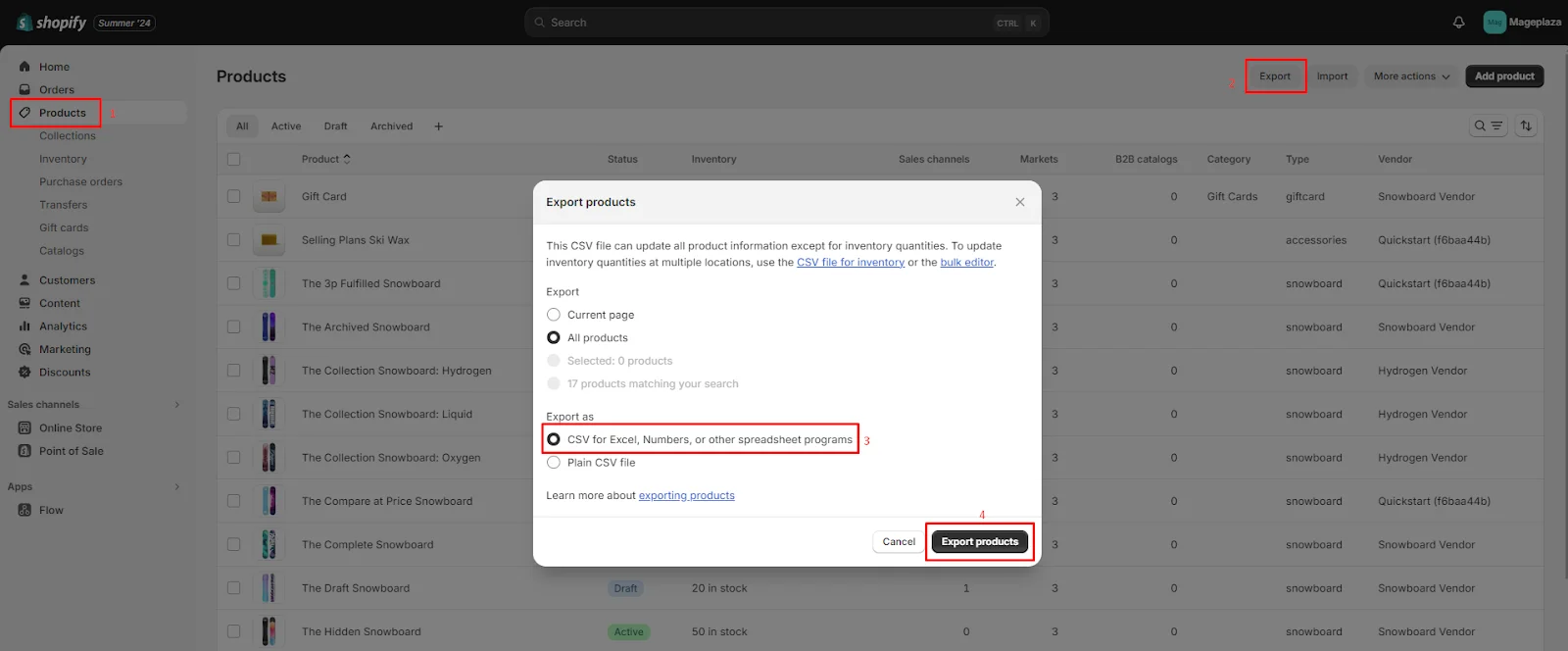
2. Download the sample CSV file from Shopify
Next, download the CSV template file that is helpful and provided by Shopify.

When importing products into Shopify, it’s essential to organize the data under the correct column headers to ensure the platform accurately maps each data point.
Failing to do this correctly can result in errors.
Manually performing this task can be complicated, highlighting the importance of using Shopify’s sample template to achieve accurate results.
3. Complete the CSV with your product information
Once you have successfully downloaded the CSV template to your computer, you should begin adding your product data to the file. This is the most time-consuming process, but make sure to do it carefully to ensure the accuracy of your data. This will protect you from potential issues during the upload and save time and effort in the long run.
Here’s a brief overview of the column headings found in the first row of your CSV file and the type of data you need to enter under each heading.
Handle
The handle serves as a unique identifier for every product. It is a lowercase string used in the product’s URL, and it cannot contain spaces or special characters. For example, a product titled “Men’s T-Shirt” might have a handle like “mens-t-shirt”.
Each handle must be unique within your store.
Title and Body (HTML)
-
Title: This is the name of your product as it will appear to customers. It should be clear and descriptive to help customers understand what the product is.
-
Body (HTML): This is the product description. You can apply HTML to style this text, adding elements like headings, lists, links, and images to make the description more informative and engaging.
Vendor, Type, Tags, and Published
- Vendor: The name of the manufacturer, wholesaler, or other vendors for the product. This helps in organizing and filtering products by vendors within your store.
- Type: This field defines the category or collection to which the product belongs, such as “Clothing”, “Accessories”, or “Electronics”. It helps in better organizing your products.
- Tags: These are keywords linked to your product that enhance searchability within your store, making it easier for customers to locate products.
- Published: This field determines if the product is visible in your store. Enter “TRUE” if the product is published and “FALSE” if it is not.
Product Variants
If your product has multiple variations, such as different sizes or colors, you’ll need to include each variant in your CSV file. Each variant should have its own row under the product, with specific details for that variant. This includes the variant’s title, SKU, price, and inventory quantity. The following 17 columns (from Option1 Name to Variant Barcode) pertain to setting up product variants.

In the Shopify CSV file, the top row is treated as the main parent listing. Thus, for the top row, you only need to complete the first eight columns (the ones previously discussed) like this:

You’ll also need to provide additional details regarding how the variants will be fulfilled and managed, including the weight in grams for each product, which is essential for calculating shipping costs.

Image Source
This field contains the URL of the product images. Each URL should be a direct link to the image file. You can include multiple images for each product by adding multiple rows with the same handle and different image URLs.
Image Alt Text
Alt text for images is crucial for both accessibility and SEO. This field should contain a brief description of the image, which helps visually impaired customers understand what the image is and also improves search engine ranking.
SEO Title and Description
- SEO Title: This is the title that will appear in search engine results for the product page. It should be brief and contain essential keywords to improve the product’s search ranking.
- SEO Description: This is the meta description that will appear in search engine results. It should provide a brief summary of the product and include relevant keywords to attract customers.

The character limit for SEO Titles is 60 and for SEO Descriptions is 150-165. This helps ensure that your message is optimized for display in Google search results.
Google Shopping Columns
These columns are specific to Google Shopping integrations. It includes 13 fields as shown in the image below. These fields help in categorizing and listing your products on Google Shopping.

Variant Image
If your product variants have different images, you can specify the image URLs for each variant in this field. Each variant should have its own row with the corresponding image URL.
Variant Weight Unit and Tax Code
- Variant Weight Unit: This field specifies the unit of measurement for the variant’s weight, such as grams (g), kilograms (kg), pounds (lb), or ounces (oz).
- Tax Code: This field contains the tax code applicable to the product, which is important for calculating sales tax correctly.
Status
This field indicates the product’s status in your store. Common statuses include “active” (product is available for purchase), “draft” (product is saved but not available for purchase), and “archived” (product is removed from the store but not deleted).
4. Ensure Your File Complies with Shopify’s Requirements
Before uploading your CSV file to Shopify, it’s crucial to ensure that your file meets Shopify’s specific formatting requirements. This step is essential to avoid errors during the import process and to ensure that your product data is accurately transferred.
Here’s how you can make sure your file complies:
- File Format: Ensure that your CSV file is saved in the correct format, which should be CSV. Shopify supports files with a .csv extension.
- Column Headers: Verify that all column headers match Shopify’s required headers exactly. These headers must be correctly spelled and formatted, as Shopify uses them to map the data correctly.
- Data Consistency: Make sure all data under each column is consistent and follows Shopify’s guidelines. For instance, ensure that image URLs are correct, product variants are listed properly, and weights are in grams.
- No Extra Columns: Remove any extra columns that are not required by Shopify. Extra or misnamed columns can lead to import errors or misconfigured product entries.
- Validation: Use Shopify’s sample CSV template as a reference to validate your file. This helps in ensuring that your file adheres to the necessary structure and format required by Shopify.
5. Upload Your CSV File and Choose Whether to Overwrite Existing Products
Once you’ve confirmed that your CSV file is correctly formatted and compliant with Shopify’s requirements, the next step is to upload the file to your Shopify store. Here’s how you can do it:
In the Products section, select Import and click Add file to upload the completed CSV file.
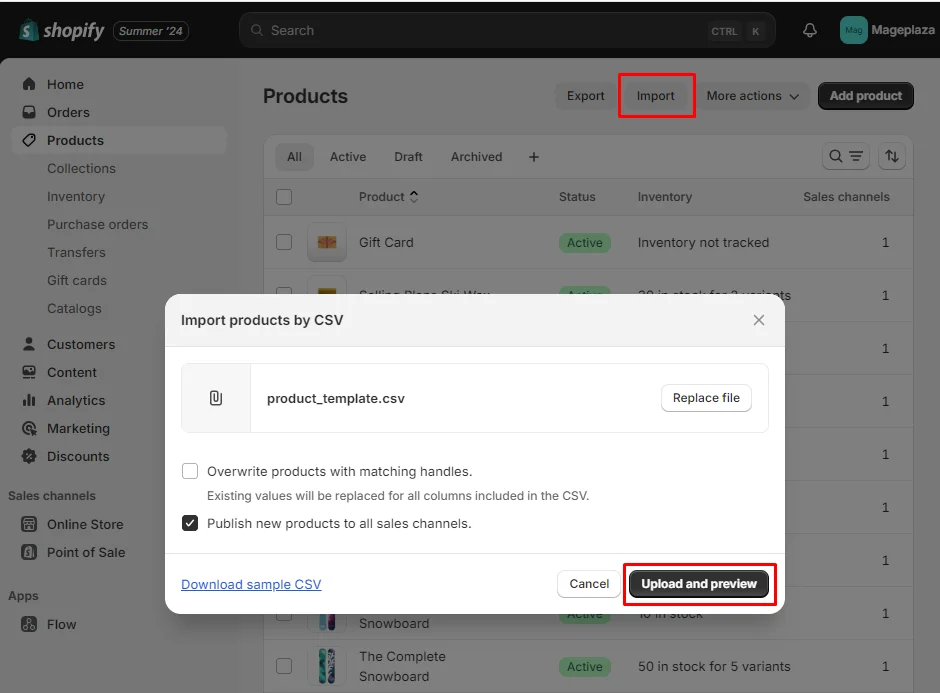
Before importing products, you’ll see two options to select based on your needs:
- Overwrite Existing Products: Verify this if you wish to replace any current products with the same handle. For example, if a product with the handle “straight-jeans-black” already exists, it will be updated with the new data, such as images and pricing.
- Publish to All Sales Channels: Select this option if you want the newly imported products to be available across all your sales channels, including your Shopify Online Store, Amazon, Walmart Marketplace, Instagram, and Facebook.
After completing all the steps, click on Upload and preview.
6. Import Your Products and Verify the Changes
After uploading the CSV file, Shopify will display a preview table for you to review before finalizing the import.
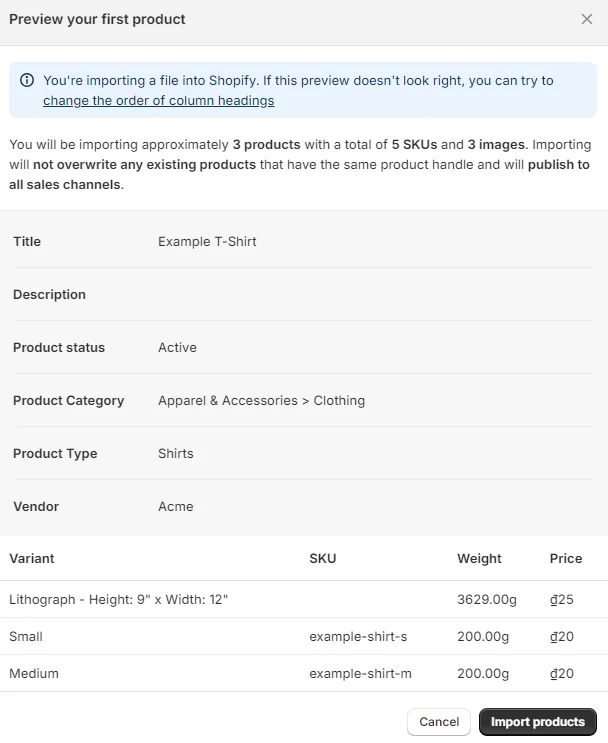
If you find any discrepancies or errors, make the necessary corrections in your CSV file and re-upload it. It may take a few iterations to ensure everything is accurate.
After thoroughly checking, click on Import products to upload your product list file, and wait a moment for Shopify to process it.
You can then check a few product pages of the newly uploaded items to ensure everything is accurate.
Tools for uploading products to Shopify
There are several tools that make this process easier and more efficient. Here are four notable tools you can use to upload products to Shopify:
1. Matrixify
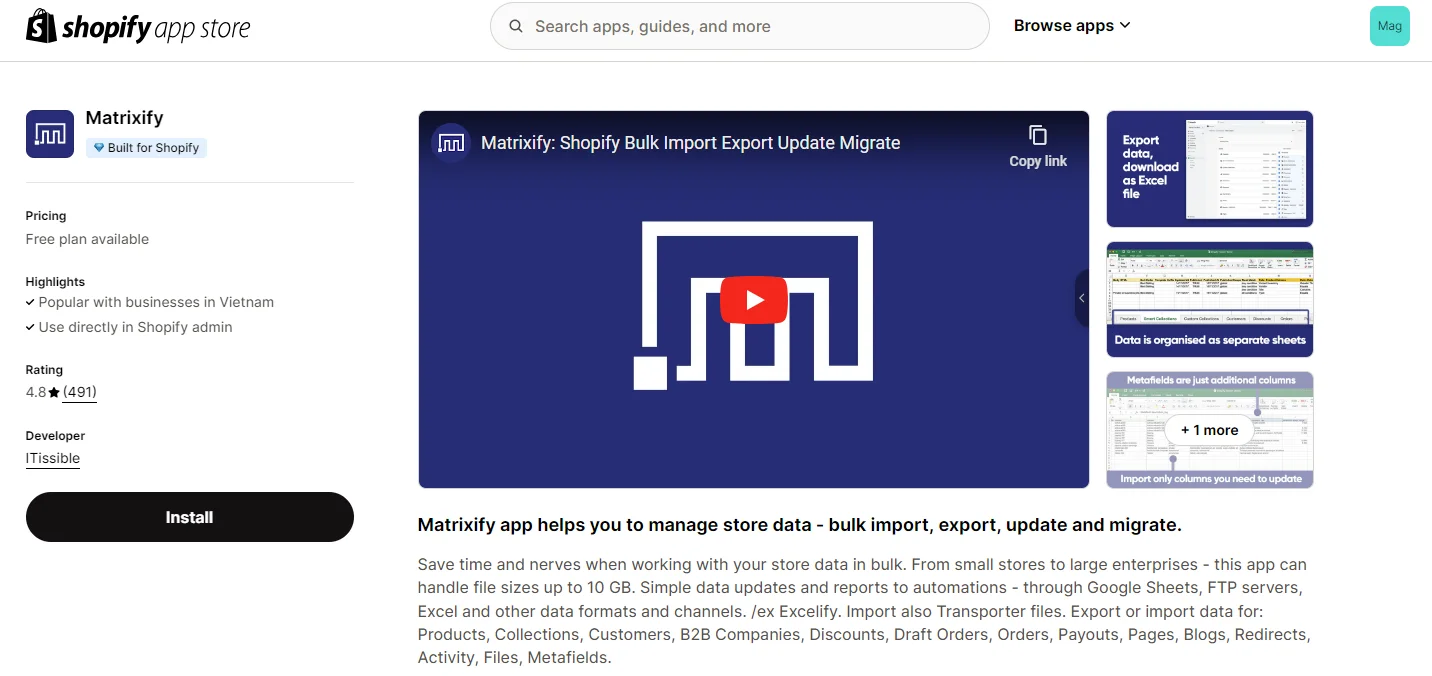 Matrixify is a popular tool for Shopify store owners to import CSV files into their catalog. It supports file sizes up to 10GB, which is significantly larger than Shopify’s manual import limit, making it ideal for handling large product datasets more efficiently.
Matrixify is a popular tool for Shopify store owners to import CSV files into their catalog. It supports file sizes up to 10GB, which is significantly larger than Shopify’s manual import limit, making it ideal for handling large product datasets more efficiently.
2. Robo Product Importer

Robo Product Importer is an easy-to-use browser extension that simplifies importing products into Shopify by scraping data from sites like Alibaba and Amazon and directly uploading it to your store. It’s especially useful for dropshipping businesses, as it automates the data transfer process from supplier pages.
3. CedCommerce Importer
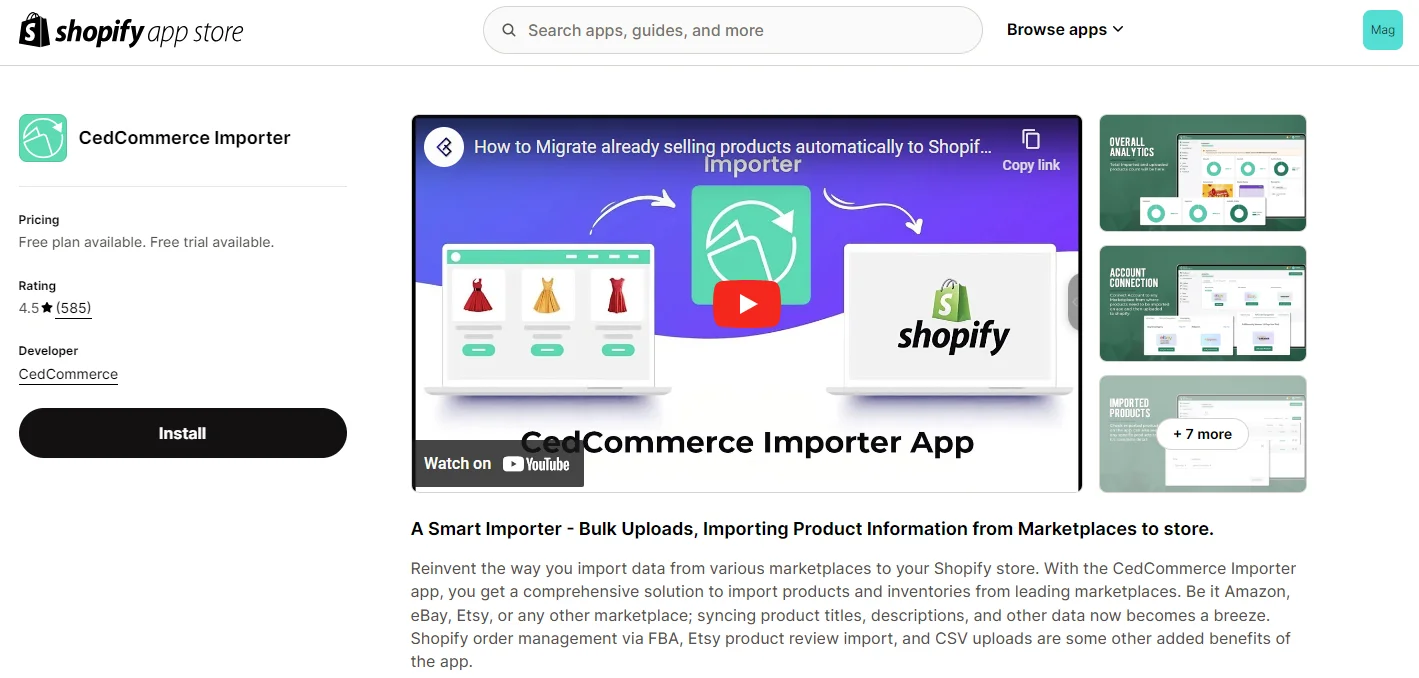
CedCommerce Importer is a useful tool for uploading products to Shopify.
It offers a free plan, with affordable paid options for those uploading 100s of products monthly.
Customers praise CedCommerce Importer for its great customer support and intuitive interface, which simplifies the import process.
Conclusion
Effectively uploading products to Shopify ensures your store’s data is accurate and up-to-date. By following the steps for preparing and importing your CSV file, and using tools for large datasets, you streamline the process and avoid common issues. Proper management of your product data enhances store efficiency and customer experience.




